A few months ago I put together a comprehensive post on how to draw in feeder birds in Minnesota. It quickly grew to be the most-read story on this blog. With that in mind, I thought it would be a helpful resource to put together a similar guide on North Dakota birds.
Below I’ve listed (in alphabetical order) birds you can attract in North Dakota, their preferred food, and the top bird feeder options. Also, I’ve provided tidbits based on my experience and some of my top food and feeder picks for birds I’ve had a lot of success with attracting.
Before diving into the specific birds, here are a handful of universal things you can do to increase your chances of bringing birds to your yard before you even hang up a feeder.
- Provide water (especially a heated bird bath in the winter)
- Avoid using pesticides
- Have trees and shrubbery nearby
- Plant native plants in your yard
- Keep your cats indoors
Bird Feeder References (links to examples on Amazon)
Bird Feed References (links to examples)
Mealworms (dried – check out your local bird store for live mealworms!)
Sunflower hearts (no shell or mess)
Authors note: I’m skipping birds of prey, rare and nuisance birds like Cowbirds, House Sparrows, Grackles, etc. in this article. If you really want these…white millet, suet and cracked corn would be my top food recommendation.
Sources: The Cornell Bird Lab, Audubon Society and a hefty dose of my firsthand experience.
Baltimore Oriole
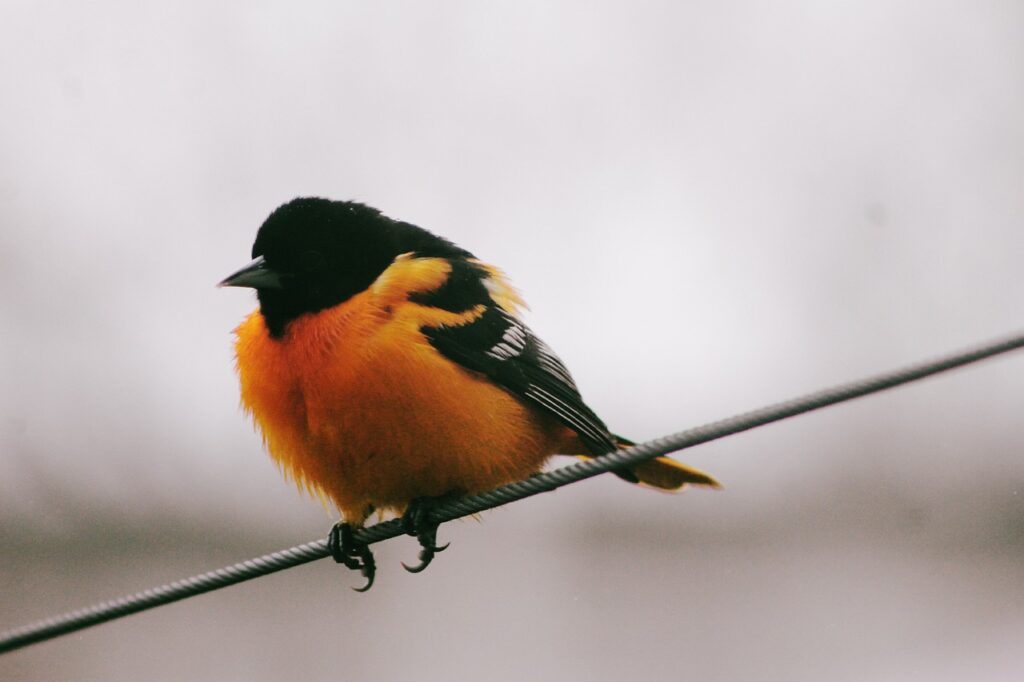
What Time of Year?
The spring and early summer (everywhere in North Dakota)
Red – Wintering Range, Blue – Breeding Season (Spring until Fall)
Image Credit: Cephas, Wikipedia

What Should You Feed Baltimore Orioles?
Grape jelly (top pick), oranges, hummingbird nectar, suet (sometimes – they have orange flavors of suet specifically for orioles, but I’ve never had luck with these). Baltimore Orioles will prefer eating mealworms later in the summer during nesting season.
What’s the Best Bird Feeder for Baltimore Orioles?
A specialty orange/jelly feeder, nectar feeder
My Top Bird Feeder Pick For Baltimore Orioles: A Flower Oriole Feeder has led to many Orioles in my yard each spring and early summer!
Other tidbits:
Baltimore Orioles typically arrive from their migration in North Dakota in late-April or May, which is the best time to have one visit your feeder. However, if they set up a nest nearby, they will visit your feeder through August.
Related Content: How to get Baltimore Orioles Visiting Your Bird Feeder
Black Headed Grosbeak
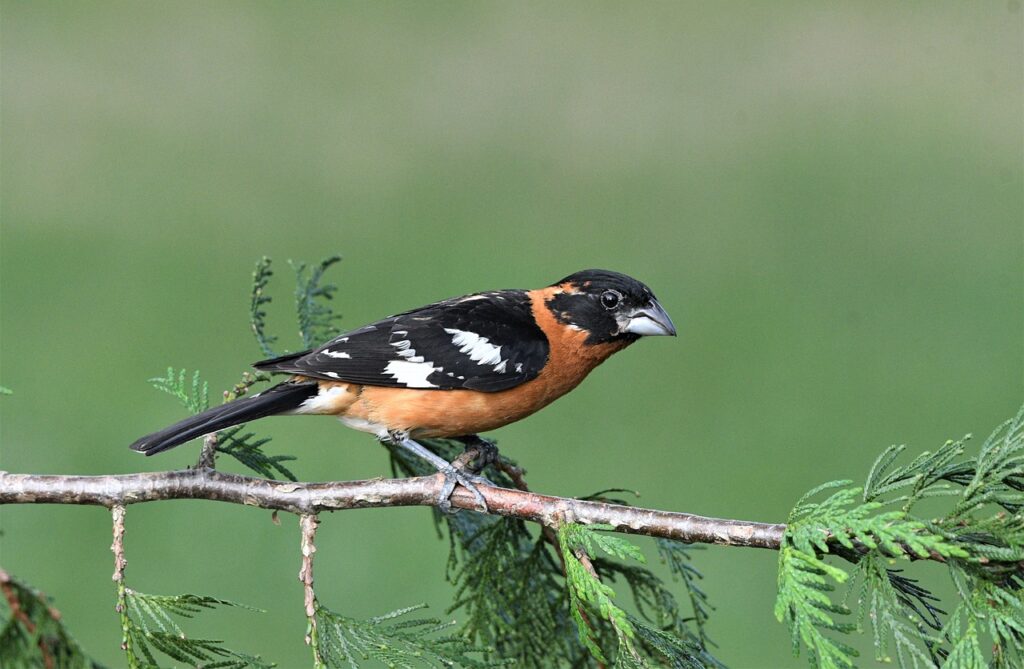
What Time of Year?
During the spring and summer in Southwestern North Dakota. Range map shown below.

Yellow: Spring migration only
Blue: Non-breeding
Purple: Year-round
Image credit: Cephas, Wikipedia
What Should You Feed Black Headed Grosbeak?
Sunflower seed! They will also visit hummingbird nectar feeders in the summer, on occasion.
What Kind of Bird Feeder is Best for Black Headed Grosbeak?
Nearly anything! Try a sturdy tube feeder, hopper feeder, or tray feeder.
Blue Jay
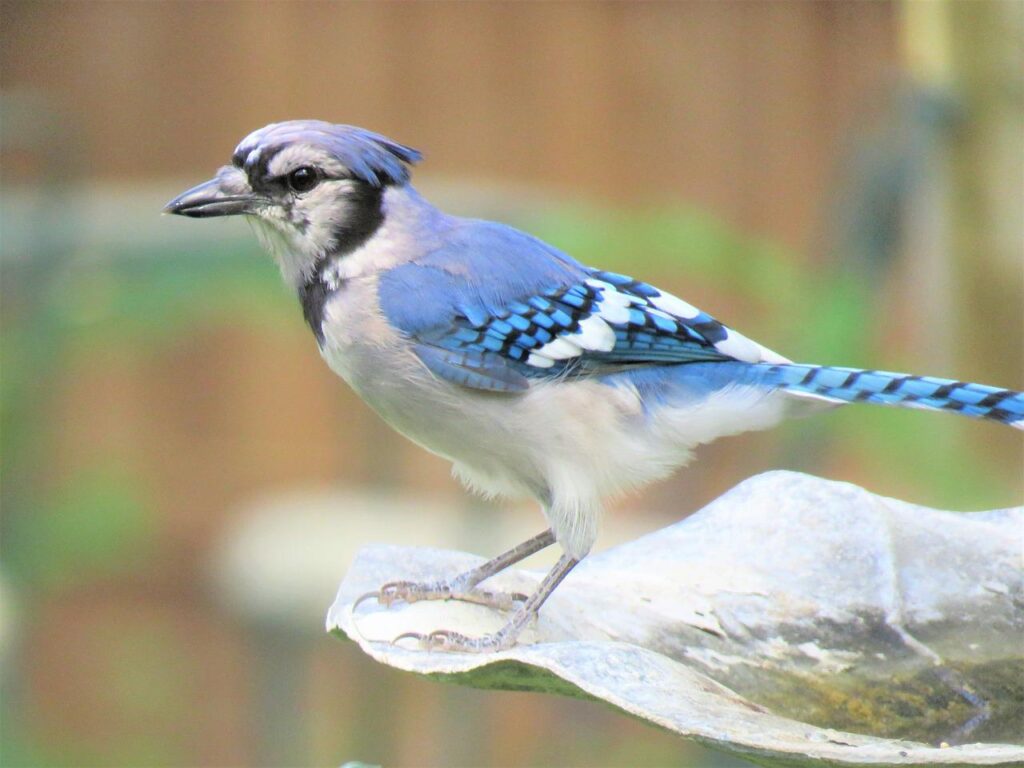
What Time of Year?
Year-round (everywhere in North Dakota)
What Should You Feed Blue Jays?
Peanuts in the shell (best bet), peanut bits, suet, sunflower seeds, corn
My Top Bird Seed Recommendation for Blue Jays:
Premium Peanuts In Shell – Wild Bird – Wildlife Food
What’s the Best Bird Feeder for Blue Jays?
Blue Jays need a sturdy house or platform feeder with a lot of room to support their weight (they’re a large feeder bird).
Other tidbits:
Attract Blue Jays with peanuts on a sturdy platform feeder, or simply serve them on the ground (beware as this will also certainly attract squirrels and chipmunks – not that I would know…).
Related Content: How to Attract Blue Jays to Your Bird Feeder
Cedar Waxwing

What Time of Year?
Year-round
Yellow – Summer Only Range, Green – Year-Round, Blue – Winter Range

What Kind of Food do Cedar Waxwings Like?
Fruit! Your best bet is to have a native tree or shrub in your yard with small berries (dogwood, cedar, winterberry, etc.).
What Kind of Bird Feeder Suits Them?
Cedar Waxwings rarely visit feeders but are known to visit bird baths in flocks. You may also have luck with a bird seed mix that has dried fruit in it.
Chickadees
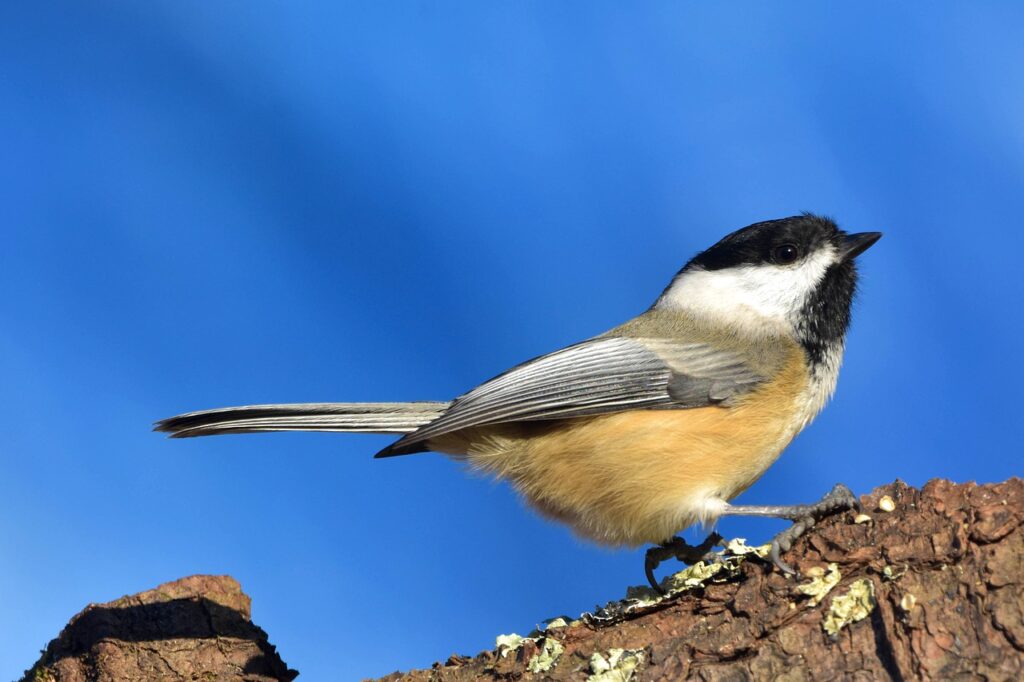
What Time of Year?
Year-round (everywhere in North Dakota)
What Kind of Food Do Chickadees Like?
Nearly everything (they’re the least picky bird I have at my feeders): Sunflower seeds, safflower seed, suet, mealworms (my Chickadee visitors especially love these).
My Top Amazon Bird Seed Recommendation for Chickadees:
What’s the Best Bird Feeder for Chickadees?
Nearly any feeder. Chickadees aren’t picky!
Related Content: 5 Surefire Tips to Attract Chickadees to Your Bird Feeder
Common Redpoll

What Time of Year?
Winter (in most of North Dakota some years)
What’s the Best Bird Seed for Redpolls?
They particularly like Nyjer seed and also sunflower chips
My Top Amazon Bird Seed Recommendation for Redpolls:
Wild Delight Special Finch Food
What’s the Best Bird Feeder for Redpolls?
A tube feeder is best (but any feeder will likely work)
Other tips?
An erratic migrating bird from Canada. You may see large groups some winters and none at all other years. It all depends on their food supply and migration route.
Dark-Eyed Junco

The Range of Dark Eyed Juncos
Yellow – Summer Breeding Range, Green – Year-Round Range, Blue – Wintering Non-Breeding Range
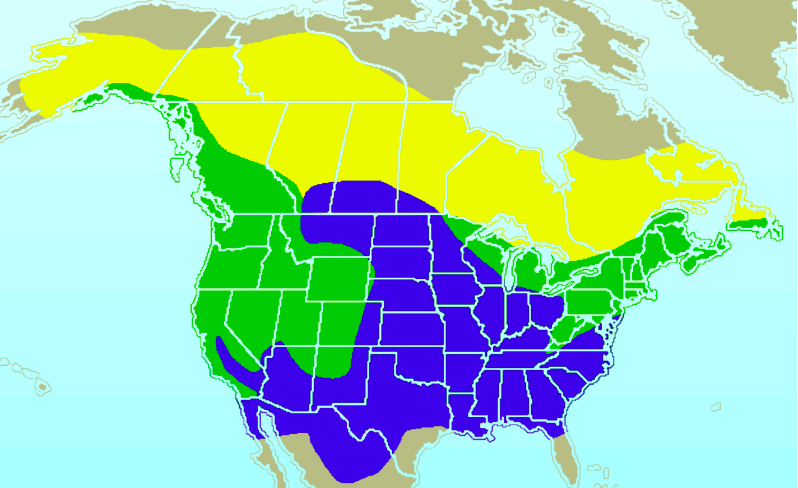
What’s the Best Bird Seed for Juncos?
Millet (best bet), hulled sunflower seed, cracked corn, peanut hearts
My Top Amazon Bird Seed Recommendation for Juncos:
What Kind of Bird Feeder is Best for Juncos?
A ground feeder (leftover seed knocked down from hanging feeders will also suffice)
Downy/Hairy Woodpecker

What Time of Year?
Year-round (everywhere and abundant in North Dakota)
What Kind of Food do They Like?
Suet (top choice – especially peanut flavored), will also eat sunflower seeds on occasion
What’s the Best Bird Feeder for Downy and Hairy Woodpeckers?
Suet feeders of all types (they aren’t picky).
My Top Amazon Bird Feeder Pick For Downy and Hair Woodpeckers:
Wildlife Sciences Suet Plug Feeder
Other tips?
Once you attract a Downy or Hairy Woodpecker to your feeders, they’ll likely be back every single day. I’ve had a pair of Downy Woodpeckers visiting my feeders for about a year now. They show up like clockwork.
Related Content: The Ultimate Guide to Attract Woodpeckers to Your Bird Feeders
Eastern Bluebird

What Time of Year?
Yellow – Summer Breeding Range, Green – Year-Round Range, Purple – Wintering Range
Credit: rbrausse, Wikipedia

What’s the Best Food for Bluebirds?
Live mealworms
What’s the Best Bird Feeder for Bluebirds?
A platform or ground feeder.
Other tips?
Getting live mealworms and putting them on a sturdy feeder is your best bet to drawing one of these awesome birds to your feeder in the warm months. Eastern Bluebirds are also highly likely to take up residence in nest boxes if you have space. You’ll probably have the best luck with that approach if you live in a more remote area.
Evening Grosbeak

The Range of Evening Grosbeaks
Green – Year-round Range, Yellow – Wintering Range
Credit – Wikipedia Commons

What’s the Best Food for Evening Grosbeaks?
Sunflower seeds
What’s the Best Bird Feeder for Evening Grosbeaks?
A hopper or platform feeder (they are heavy finches)
Other tips?
Irregular migrants and not likely to visit your feeders consistently every year. If they do, they will often appear in large flocks and eat a lot of sunflower seeds. That’s not a bad problem to have. These birds look awesome!
Goldfinch

The Range of the American Goldfinch
Orange – Summer Breeding Range, Purple – Year-Round Range, Blue – Winter Range

What’s the Best Bird Seed for Goldfinches?
Sunflower chips (my top choice) and nyjer seed
My Top Online Bird Seed Recommendation for Goldfinches:
Valley Farms Sunflower Hearts Wild Bird Food – 15 lbs
What kind of bird feeder suits them?
Just about any kind, but tube feeders are best. You can also use a sock feeder filled with nyjer seed for Goldfinches.
Other tips?
If you have the means to do so, plant native thistle plants as an organic way to attract Goldfinches to your yard!
Related: 4 Tips for Attracting American Goldfinches to your Yard
Gray Catbird

The Range of the Gray Catbird
Orange: Summer breeding, Yellow: Spring migration, Purple: Year-Round, Blue: Wintering Range

What’s the Best Bird Feed and Feeder for Catbirds?
Catbirds can be drawn to feeders with fruit or grape jelly. If you have a Baltimore Oriole feeder out in the spring and summer, you may also have Gray Catbirds stopping by.
Other Tips?
The Cornell Bird Lab says you should plant shrubs in your yard near young deciduous trees to attract Catbirds. You can also plant native plants with fruit to naturally draw them to your home.
Indigo Bunting

Range of Indigo Bunting
Yellow: Summer Range, Green: Migrating Range, Blue: Winter Range
Image Credit: Wikipedia Commons
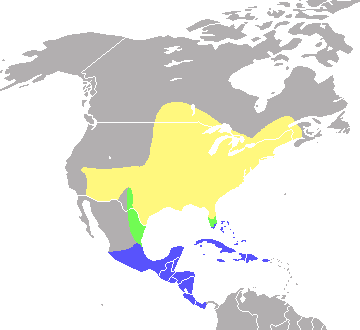
What’s the Best Bird Seed for Indigo Bunting?
White millet (best choice), hulled sunflower seed, nyjer seed
What’s the Best Bird Feeder for Indigo Bunting?
They enjoy eating from the ground, or on small tube feeders
Other tips?
This can be a challenging bird to attract (at least it has been for me). Your best bet is to have your feeders stocked in the spring with white millet and catch them during their migration.
Mourning Dove

The Range of Mourning Doves
Orange: Summer Breeding Range, Purple: Year-Round Range, Blue: Non Breeding Winter Range – Image Source: Wikipedia Creative Commons

What’s the Best Bird Seed for Mourning Doves?
White millet (best choice), sunflower seeds, corn
My Top Amazon Bird Seed Recommendation for Mourning Doves:
What kind of bird feeder suits them?
A large platform or ground feeder
Other tips?
Unless you have a large and steady platform feeder, sprinkling millet on the ground is perfect for Mourning Doves. They’re big birds and need a sturdy place to sit.
Northern Cardinal
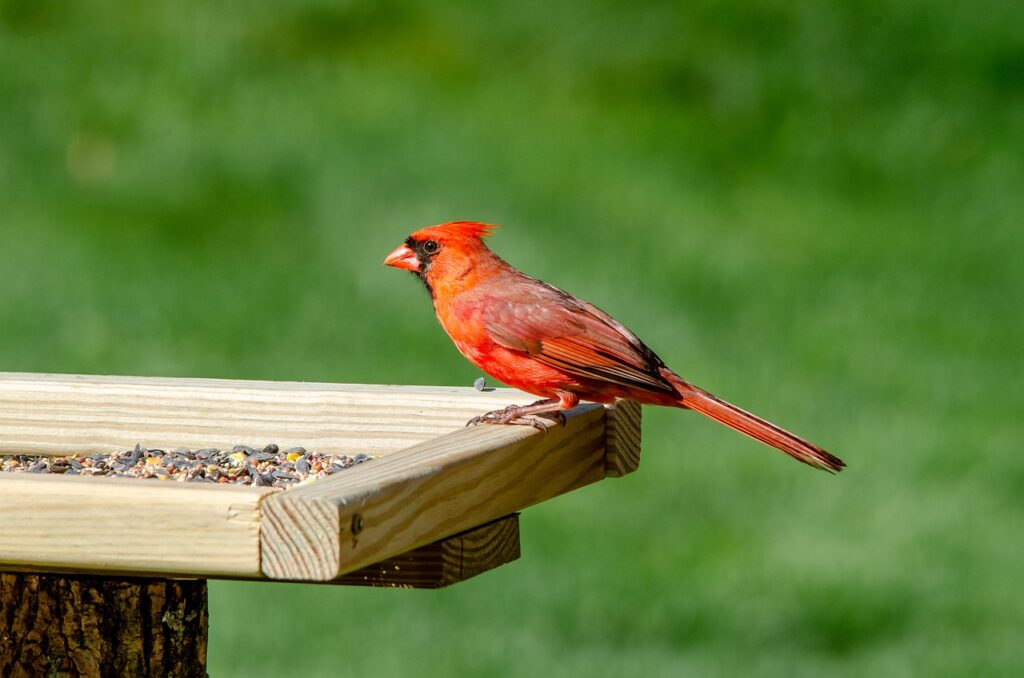
What Time of Year?
Year-round but typically only on a sliver of the Southeastern portion of the state.
What’s the Best Bird Seed for Cardinals?
Sunflower seeds (top choice – black oil sunflower), safflower seed, millet, peanuts. There are Cardinal bird seed blends with both sunflower and safflower seeds.
My Top Amazon Bird Seed Recommendation for Cardinals:
Meadow Ridge Farms Black Oil Sunflower Seed
What’s the Best Bird Feeder for Cardinals?
A large platform or ground feeder are the best bird feeders for Cardinals. They will visit most feeders as long as they can support their weight. Cardinals are larger songbirds (7 to 9 inches long).
Other tips?
Have your feeders in a quiet spot with bushes or trees nearby. Cardinals are shy birds and will want to scout out feeders and have a safe place to hide if they feel threatened. In the winter, when they aren’t competing for mates, you have a good chance of attracting several Cardinals at sunrise and sunset.
For more detail, check out my story with 5+ tips for attracting Cardinals to your yard!
Northern Flicker

What Time of Year?
Year-round everywhere in North Dakota.
What kind of food do Northern Flickers like?
A rare visitor to feeders (but often use bird baths). Will eat sunflowers, peanuts and suet on occasion
What’s the Best Bird Feeder for Northern Flickers?
A suet or ground feeder
Other tips?
Northern Flickers will use large nest boxes if you have space for one in your yard.
Range of Northern Flickers
Orange: Breeding, Purple: Year-Round, Blue: Non-Breeding

Pileated Woodpecker

What Time of Year?
Year-round (but only on a sliver of the Eastern part of North Dakota).

What’s the Best Food for Pileated Woodpeckers?
Suet (top choice)
What’s the Best Bird Feeder for Pileated Woodpeckers?
A large suet cage or platform.
Other tips?
Pileated Woodpeckers are HUGE. So, you’ll want to get a suet feeder that’s big enough to support them. Some suet feeders come with large platforms underneath, giving the bird room to balance using its tail. You’ll typically find them in wooded areas. Seeing them at a bird feeder in the suburbs is more tricky, but not impossible.
Pine Grosbeak

What Time of Year?
Winter throughout North Dakota
What’s the Best Bird Seed for Pine Grosbeaks?
Sunflower seeds (best choice) and suet
What’s the Best Bird Feeder for Pine Grosbeaks?
Large tube, platform and hopper feeders
Other tips?
According to The Cornell Bird Lab, Pine Grosbeaks may also be seen eating grit near roads by forests.
Pine Siskin

What Time of Year?
During the winter throughout North Dakota.
Purple: Year-Round, Blue: Winter, Orange: Summer
Source: Cephas, Wikipedia
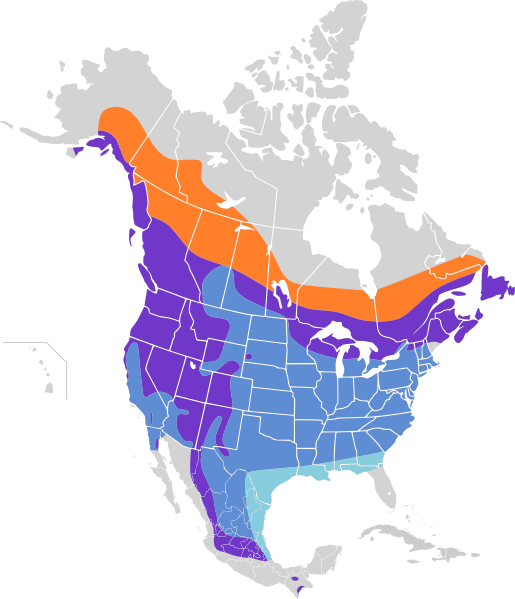
Purple: Year-Round
Dark Blue: Winter
What’s the Best Bird Seed for Pine Siskins?
Nyjer seed, hulled sunflower seeds, suet (maybe).
My Top Amazon Bird Seed Recommendation for Pine Siskins:
Wild Delight Special Finch Food
What’s the Best Bird Feeder for Pine Siskins?
Nearly anything! The Pine Siskin that visits me often loves the large tube feeder I have with a finch blend.
Other tips?
This is another erratic bird based off its food supply and migration. The Cornell Bird Lab says: “Flocks of tiny Pine Siskins may monopolize your thistle feeder one winter and be absent the next.”
Purple Finch

What Time of Year?
In the winter only across Northern North Dakota. This is a rarer bird in the state. You may also spot them during spring migration across the Eastern half of North Dakota.
Pink: Summer, Orange: Winter, Green: Year-Round
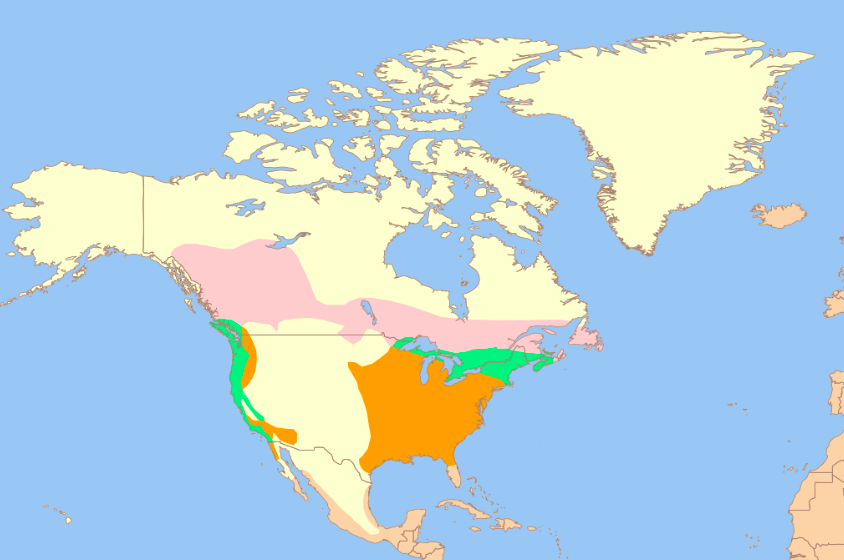
Green: Year-Round
Pink: Summer range
Image Credit: Nk, Wikipedia
What’s the Best Bird Seed for Purple Finches?
Sunflower seed (top choice), safflower seed, nyjer
What’s the Best Bird Feeder for Purple Finches?
Just about anything.
Other tidbits?
Purple Finches are more rare than the similar looking House Finches. Male Purple Finches have a red cap versus a brown cap for House Finches.
Red Breasted Nuthatch

What Time of Year?
During the winter throughout the entire state.
Purple: Year-Round, Blue: Non-breeding
Credit: Cephas, Wikipedia

What’s the Best Food for Red Breasted Nuthatches?
Peanuts, suet and sunflower seeds
What’s the Best Bird Feeder for Red Breasted Nuthatches?
Almost anything
Other tips?
Offer an assortment of seeds on a variety of feeders to attract nuthatches. They will often sample several seeds before picking their favorite and fly off.
Robin

What Time of Year?
Year-round (more common in the spring through fall), everywhere in North Dakota.
What’s the Best Food for Robins?
Fruits (apples, oranges, berries, raisins), mealworms
What’s the Best Bird Feeder for Robins?
Food on the ground or a large platform feeder. Robins are hard to draw to feeders. The ground is your best best!
Other tips?
I haven’t had luck bringing a robin directly to my feeders. However, they’re familiar visitors in the surrounding area looking for worms and berries in trees. Try putting out diced fruit like apples in the springtime and you can get lucky.
Rose Breasted Grosbeak

What Time of Year?
Spring and summer. You’ll only catch them during the spring migration on the Western half of the state (see range map below).
What’s the Best Bird Seed for Rose Breasted Grosbeaks?
Sunflower (top choice), safflower
What’s the Best Bird Feeder for Rose Breasted Grosbeaks?
A large platform, hopper or tube feeder
Other tips?
They’re likely to visit feeders in the late spring during migration when they need extra energy. Have native berry plants and shrubs in your yard for another chance to attract these birds.
The Range of Rose-Breasted Grosbeak
Yellow: Breeding-Range, Orange: Migration-Only, Blue: Winter-Range

Ruby Throated Hummingbird

What Time of Year?
During their late spring migration and through the summer (better odds of that in the Eastern-portion of the state).
What’s the Best Food for Hummingbirds?
Nectar, flowers in your yard. You can easily make your own hummingbird nectar from home by combining four parts water with one part table sugar. Here’s a short video showing you how below.
IMPORTANT: You absolutely must completely clean out your hummingbird feeders every other day at minimum. Clean them every day if it’s hot outside or if the feeders are in direct sunlight. The nectar easily starts growing bacteria and mold. This can harm or kill the hummingbird!
What’s the Best Bird Feeder for Hummingbirds?
A nectar hummingbird feeder that has the color red or yellow. Both of those colors attract hummingbirds! I tend to pick red-colored feeders because yellow can also attract bees.
Here’s a link to a roundup of some of the best hummingbird feeders you can find online.
Other tips?
I’ve also had luck attracting hummingbirds by hanging up a native flower plant in the summer. I’ve also seen them be curious of my orange/jelly feeder for Orioles.
Related: How to Attract Hummingbirds to a Feeder in Just Three Steps
Range Map for Ruby Throated Hummingbirds
Orange: Summer, Yellow: Migration-Only, Blue: Winter-Range

Sparrows (Native)

*I’m lumping Song Sparrows and Chipping Sparrows, etc. here
What Time of Year?
Spring and summer – Everywhere in North Dakota
What’s the Best Bird Seed for Sparrows?
Millet (top choice), sunflower seeds, cracked corn, milo
My Top Amazon Bird Seed Recommendation for Sparrows:
What’s the Best Bird Feeder for Sparrows?
Just about anything
Other tips?
Mix in some millet into your sunflower seeds to attract native sparrows in the spring.
Western Tanager

What Time of Year?
During spring migration in Western North Dakota. They spend the summer nesting season further north and west. Range map below.
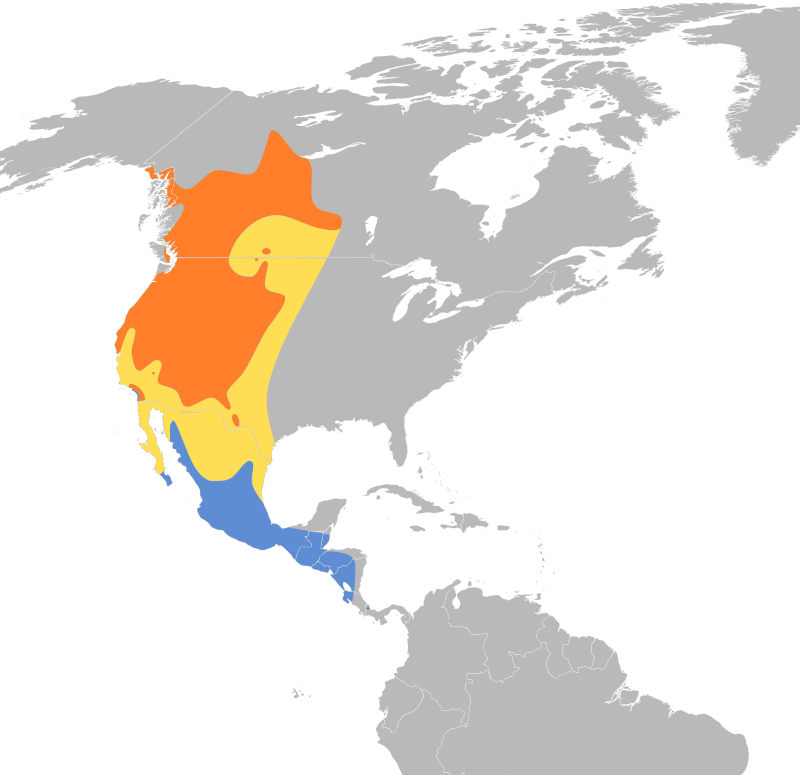
Orange: Summer nesting
Blue: Winter
Image credit: Cephas, Wikipedia
What’s the Best Bird Seed for Western Tanager?
They don’t eat seeds, BUT they may drop by for some energizing fruit (like oranges) at a bird feeder. A bird bath will also increase your odds, just like with any other bird. Good luck!
What’s the Best Bird Feeder for Western Tanager?
Any Oriole feeder where you can stick a sliced orange on it!
White Breasted Nuthatch

What Time of Year?
Year-round (everywhere in North Dakota)
What’s the Best Bird Seed for White Breasted Nuthatches?
Peanut bits (top choice), sunflower, suet, safflower
My Top Amazon Bird Seed Recommendation for White Breasted Nuthatch:
Lyric Peanut Pieces Wild Bird Food
What kind of bird feeder suits them?
Just about anything
Other tips?
A common year-round visitor for me. Listen for their nasal call – I’ll often hear a nuthatch before it arrives on my feeders. They are acrobatic and will often hand upside down on my feeders.
Yellow-Bellied Sapsucker

What Time of Year?
Spring – Summer! Some will nest through the breeding season in the Northeast portion of the state. Range map below.

Yellow: Spring migration
Blue: Wintering range
Image credit: Cephas, Wikipedia
What’s the Best food for Yellow-Bellied Sapsuckers?
Suet
What’s the Best Bird Feeder for Yellow-Bellied Sapsuckers?
A suet feeder
Other tips?
Rarely visit feeders but may drop by for some suet on occasion. As their name suggests, most of their diet is sap from maple or birch trees.
Related: The Definitive Bird Seed Power Rankings
Disclaimer: Some links found on this page might be affiliate links. If you click an affiliate link and make a purchase, I might earn a commission. As an Amazon Associate I earn from qualifying purchases.
